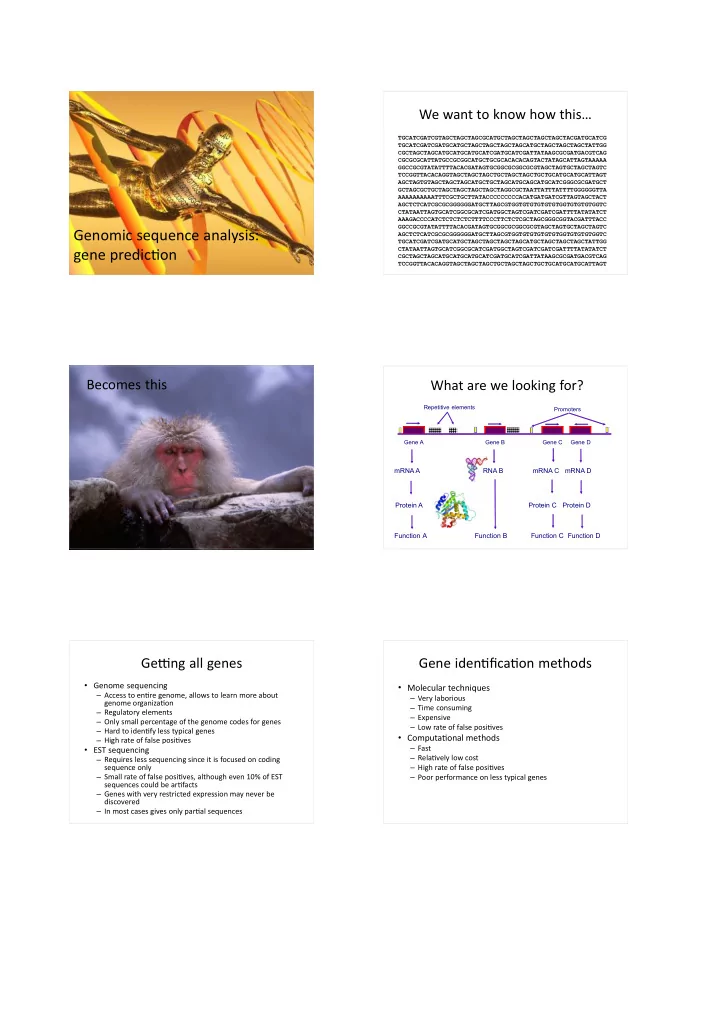

We ¡want ¡to ¡know ¡how ¡this… TGCATCGATCGTAGCTAGCTAGCGCATGCTAGCTAGCTAGCTAGCTACGATGCATCG TGCATCGATCGATGCATGCTAGCTAGCTAGCTAGCATGCTAGCTAGCTAGCTATTGG CGCTAGCTAGCATGCATGCATGCATCGATGCATCGATTATAAGCGCGATGACGTCAG CGCGCGCATTATGCCGCGGCATGCTGCGCACACACAGTACTATAGCATTAGTAAAAA GGCCGCGTATATTTTACACGATAGTGCGGCGCGGCGCGTAGCTAGTGCTAGCTAGTC TCCGGTTACACAGGTAGCTAGCTAGCTGCTAGCTAGCTGCTGCATGCATGCATTAGT AGCTAGTGTAGCTAGCTAGCATGCTGCTAGCATGCAGCATGCATCGGGCGCGATGCT GCTAGCGCTGCTAGCTAGCTAGCTAGCTAGGCGCTAATTATTTATTTTGGGGGGTTA AAAAAAAAAATTTCGCTGCTTATACCCCCCCCCACATGATGATCGTTAGTAGCTACT AGCTCTCATCGCGCGGGGGGATGCTTAGCGTGGTGTGTGTGTGTGGTGTGTGTGGTC CTATAATTAGTGCATCGGCGCATCGATGGCTAGTCGATCGATCGATTTTATATATCT AAAGACCCCATCTCTCTCTCTTTTCCCTTCTCTCGCTAGCGGGCGGTACGATTTACC GGCCGCGTATATTTTACACGATAGTGCGGCGCGGCGCGTAGCTAGTGCTAGCTAGTC Genomic ¡sequence ¡analysis: ¡ AGCTCTCATCGCGCGGGGGGATGCTTAGCGTGGTGTGTGTGTGTGGTGTGTGTGGTC TGCATCGATCGATGCATGCTAGCTAGCTAGCTAGCATGCTAGCTAGCTAGCTATTGG gene ¡predic4on CTATAATTAGTGCATCGGCGCATCGATGGCTAGTCGATCGATCGATTTTATATATCT CGCTAGCTAGCATGCATGCATGCATCGATGCATCGATTATAAGCGCGATGACGTCAG TCCGGTTACACAGGTAGCTAGCTAGCTGCTAGCTAGCTGCTGCATGCATGCATTAGT Becomes ¡this What ¡are ¡we ¡looking ¡for? Repetitive elements Promoters Gene A Gene B Gene C Gene D mRNA A RNA B mRNA C mRNA D Protein A Protein C Protein D Function A Function B Function C Function D Ge>ng ¡all ¡genes Gene ¡iden4fica4on ¡methods • Genome ¡sequencing • Molecular ¡techniques – Access ¡to ¡en4re ¡genome, ¡allows ¡to ¡learn ¡more ¡about ¡ – Very ¡laborious genome ¡organiza4on – Time ¡consuming – Regulatory ¡elements – Expensive – Only ¡small ¡percentage ¡of ¡the ¡genome ¡codes ¡for ¡genes – Low ¡rate ¡of ¡false ¡posi4ves – Hard ¡to ¡iden4fy ¡less ¡typical ¡genes • Computa4onal ¡methods – High ¡rate ¡of ¡false ¡posi4ves – Fast • EST ¡sequencing – Rela4vely ¡low ¡cost – Requires ¡less ¡sequencing ¡since ¡it ¡is ¡focused ¡on ¡coding ¡ sequence ¡only – High ¡rate ¡of ¡false ¡posi4ves – Small ¡rate ¡of ¡false ¡posi4ves, ¡although ¡even ¡10% ¡of ¡EST ¡ – Poor ¡performance ¡on ¡less ¡typical ¡genes sequences ¡could ¡be ¡ar4facts – Genes ¡with ¡very ¡restricted ¡expression ¡may ¡never ¡be ¡ discovered – In ¡most ¡cases ¡gives ¡only ¡par4al ¡sequences
Genome ¡sequencing Shotgun ¡sequencing ¡is ¡ the ¡method ¡of ¡choice ¡ for ¡small ¡genomes Shotgun Clone into vector Sequencing Assembly Clone-‑by-‑clone ¡approach Repe66ve ¡sequences ¡make ¡ correct ¡assembly ¡difficult Gene ¡finding ¡methods ¡classifica4on Before ¡we ¡start ¡analysis… Similarity based predictors : make use of similarity to already • We ¡have ¡to: known genes and proteins coded by these genes as well as – Check ¡sequences ¡quality expression data including sequences from cDNAs and data – Remove ¡contamina4on from hybridization experiments (tiling arrays for example) – Assembly ¡sequence ¡reads ¡into ¡longer ¡con4gs Dual- and multi-genome predictors: – Close ¡gaps ¡(in ¡perfect ¡situa4on) rely on the fact that functional regions of a genome sequence are more conserved during evolution Model based predictors : use a single genome sequence and exon/ intron structure is predicted based on absolute and bulk properties of the sequence
Comparative genomics - Comparative genomics - Similarity ¡search MultiPipMaker MultiPipMaker • We ¡can ¡check ¡if ¡any ¡fragment ¡of ¡our ¡sequence ¡ shows ¡similarity ¡to ¡already ¡known ¡protein. ¡We ¡ can ¡also ¡check ¡if ¡there ¡are ¡any ¡mRNA ¡ sequences ¡and ¡ESTs ¡which ¡align ¡well ¡with ¡the ¡ genomic ¡sequence. ¡Based ¡on ¡similarity ¡we ¡can ¡ deduct ¡the ¡gene ¡structure ¡and ¡protein ¡ func4on http://pipmaker.bx.psu.edu/pipmaker/ Model ¡based ¡methods All ¡informa4on ¡is ¡in ¡the ¡DNA. ¡We ¡just ¡have ¡to ¡ learn ¡how ¡to ¡read ¡the ¡code, ¡the ¡program ¡for ¡life. • We ¡take ¡advantage ¡of ¡what ¡we ¡already ¡ learned ¡about ¡gene ¡structures ¡and ¡features ¡of ¡ coding ¡sequences. ¡Based ¡on ¡this ¡knowledge ¡ TGCATCGATCGTAGCTAGCTAGCGCATGCTAGCTAGCTAGCTAGCTACGATGCATCG TGCATCGATCGATGCATGCTAGCTAGCTAGCTAGCATGCTAGCTAGCTAGCTATTGG we ¡can ¡build ¡theore4cal ¡model, ¡develop ¡an ¡ CGCTAGCTAGCATGCATGCATGCATCGATGCATCGATTATAAGCGCGATGACGTCAG algorithm ¡to ¡search ¡for ¡important ¡features, ¡ CGCGCGCATTATGCCGCGGCATGCTGCGCACACACAGTACTATAGCATTAGTAAAAA GGCCGCGTATATTTTACACGATAGTGCGGCGCGGCGCGTAGCTAGTGCTAGCTAGTC train ¡it ¡on ¡known ¡data ¡and ¡use ¡to ¡search ¡for ¡ TCCGGTTACACAGGTAGCTAGCTAGCTGCTAGCTAGCTGCTGCATGCATGCATTAGT coding ¡sequences ¡in ¡anonymous ¡genomic ¡ AGCTAGTGTAGCTAGCTAGCATGCTGCTAGCATGCAGCATGCATCGGGCGCGATGCT GCTAGCGCTGCTAGCTAGCTAGCTAGCTAGGCGCTAATTATTTATTTTGGGGGGTTA fragments AAAAAAAAAATTTCGCTGCTTATACCCCCCCCCACATGATGATCGTTAGTAGCTACT AGCTCTCATCGCGCGGGGGGATGCTTAGCGTGGTGTGTGTGTGTGGTGTGTGTGGTC CTATAATTAGTGCATCGGCGCATCGATGGCTAGTCGATCGATCGATTTTATATATCT AAAGACCCCATCTCTCTCTCTTTTCCCTTCTCTCGCTAGCGGGCGGTACGATTTACC Gene4c ¡code Program ¡for ¡life • DNA ¡in ¡our ¡cells ¡store ¡informa4on ¡in ¡a ¡way ¡that ¡is ¡very ¡similar ¡to ¡the ¡way ¡computers ¡do. • Instead ¡of ¡being ¡a ¡binary ¡memory, ¡where ¡everything ¡is ¡either ¡0 ¡or ¡1, ¡DNA ¡is ¡a ¡4 ¡le]er ¡ alphabet: ¡A, ¡C, ¡G, ¡T • Using ¡computer ¡metaphor ¡we ¡can ¡say ¡that: – Plant ¡cell ¡do ¡not ¡look ¡like ¡a ¡mouse ¡cell ¡because ¡their ¡“programs” ¡are ¡different – Liver ¡cells ¡work ¡differently ¡than ¡lung ¡cells ¡because ¡of ¡different ¡input ¡to ¡the ¡program ¡ – Children ¡look ¡like ¡parents ¡because ¡their ¡program ¡is ¡a ¡“revision” ¡of ¡parents ¡program – Many ¡diseases ¡are ¡caused ¡by ¡“bugs” ¡in ¡program: • Familial ¡dysautonomia: ¡A ¡simple ¡mistake ¡in ¡one ¡line ¡of ¡code • Hun4ngton’s ¡disease: ¡A ¡“line” ¡of ¡code ¡gets ¡repeated ¡a ¡bunch ¡of ¡4mes ¡by ¡ accident • Different ¡ways ¡to ¡solve ¡the ¡same ¡problem: – Plants: ¡photosynthesis ¡= ¡turn ¡light ¡into ¡sugar – Animals: ¡eat ¡plant ¡or ¡other ¡animals
Gene4c ¡code From ¡DNA ¡to ¡protein ATGGTCCTACACACGATCGATCGATCGATGTGA ATG GTC CTA CAC ACG ATC GAT CGA TGC ATG TGA M V L H T I N R C M STOP M L V C I N R H M T Pseudogenes ¡and ¡repe44ve ¡elements Gene ¡structure Genes ¡may ¡overlap Complicated ¡gene ¡structures
Recommend
More recommend